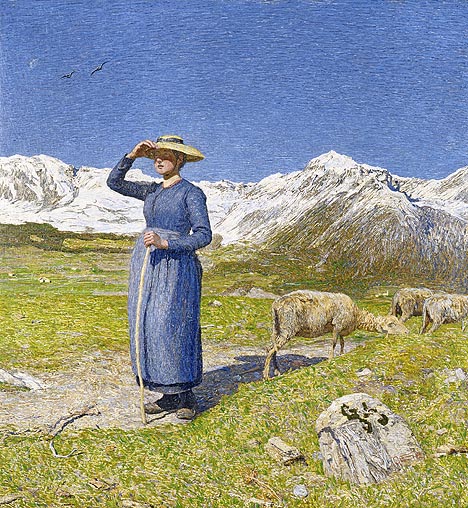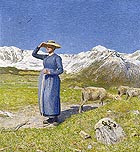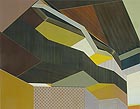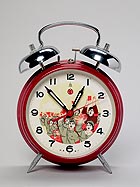
translated and summarized by: Liz Wollner-Grandville,
English summaries March 7 - 21
Fondation Beyeler
Segantini
16.01.11 – 25.04.11
Painting and wanderlust
I don’t like mountains, I love the sea (just like I don’t like dogs, but cats, and I like Bernini but not Borromini or Greenberg’s Theory of Modernism but not Rosenberg’s Theory on Action Painting). On my last mountain tour 15 years ago to Mouttas Muragl, the 2500m high mountain in St. Moritz, Switzerland, I boarded a cable car and then walked quite a long distance before I finally reached my destination: the Schafberg. It was then that I was able to see with my own eyes what had induced Giovanni Segantini to come here. And there is a hut, a kind of lieu de mémorie, which reminds us that already in 1899 the art industry was bereft of great talents on account of a ruptured appendix – the illness that had killed Segantini in just this hut.
Foremost, Segantini preferred to paint on-scene. He worked on his Alps-triptych, which narrated the story of “becoming-being-and ceasing”. The middle part was created with a view of the panorama as seen from the Schafberg, For the first part of the triptych Segantini travelled to Bergell and for the last part to Maloja. I had the urge to follow his footsteps. I noticed that the master had not only meticulously adhered to the silhouettes, ridges, and peaks, but that he had moved his motives closer together than they actually were. One can definitely say, after comparing his painting in the museum with the on-site view in St. Moritz, that Segantini was a virtuoso of concretion. And let’s be honest, one can expect a little more than the pure transformation on a one-on-one basis.
The Fondation Beyeler is currently showing a retrospective of the painter's work (however without the triptych). Segantini never had a nationality and he was also an internationalist as a painter - apart from certain mountain regions. He was not an artist who took up the pointillist technique, as practiced in Paris, or the style of Naturalism, which was en vogue at his time – he did not permit these styles to influence his paintings, in which something like wanderlust can be felt. Segantini’s works are showpieces of a quality that the avant-garde will not appreciate. Visually they are of the highest and absolutely banal attractiveness, they are optical sensations and their colourings are advertisements in their own, artistic and in their touristic right. None other would I have followed.
By Rainer Metzger
Fondation Beyeler
4125 Riehen /Basel, Baselstrasse 101
Tel:+41 (0)61 645 97 00
Tel:+41 (0)61 645 97 19
Email: foundation@beyeler.com
http://www.beyeler.com
Opening hours: Mon – Sun: 10 a.m. – 6 p.m.
Strabag Kunstforum
Aurelia Gratzer – shaft
25.02.11 – 25.03.11
Magnificently decorative
In SHAFT, Aurelia Gratzer, born 1978, presents beautiful paintings that match the Artlounge's austere and modern architecture. Gratzer’s probably most outstanding large-format acrylic painting is effectually positioned immediately next to the entrance area. The painting called “Rata Tata” offers a well composed and harmonious choice of colours while the other works appear as if they continuously followed the same pattern of abstracting photos from a attlifestyle magazine, lacking any personal touch.
Taking a closer look, the incredible precision of the abstract compositions is striking. They consist of coloured areas that are partly decorated with wallpaper-like patterns. The biggest weakness of the otherwise outstanding paintings by Aurelia Gratzer is the similarity to the stringency and cleanliness of digitally generated images. The works lack all excitement or eccentrics – even if this does not make them less attractive it definitely makes them less interesting than such talent would have doubtlessly deserved.
By Wolfgang Pichler
Strabag Kunstforum
1120 Vienna, Donau-City Strasse 9
Tel.: +43 1 224 22 1848
Fax: +43 1 224 22 1847
Email: kunstforum@strabag.com
http://www.strabag-kunstforum.at
Opening hours: Mon – Thu 9 a.m. – 5 p.m., Fri 9 a.m. – Noon
Museum für Völkerkunde
The Culture of the Cultural Revolution – Personality Cult and political design in Mao's China
18.02.11 - 19.09.11
red, shiny, gleaming, illustrious, significant, comprehensive
“Serve the people” is written in Mao’s handwriting on the lid of a teapot. On its side another Mao quote, and beneath it the depiction of an unusual landscape: a field “populated” by a power plant, power poles, factories and a tractor.
Since 2005, this teapot is in the possession of the Völkerkundemuseum, and, together with numerous everyday objects (plaques, caricatures, decorated utilities) it is presented in the exhibition “The Culture of the Cultural Revolution – Personality Cult and Political Design in Mao’s China”. The “most banal things of everyday life”, dating from the time of the Cultural Revolution (1966 – 1976), were collected by the journalist and expert on China, Helmut Opletal, who received most of the objects as gifts from his Chinese friends. In the meantime, the Mao tokens have become most sought after collector’s items and were relaunched to mark the occasion of Mao’s 100th birthday (1893 – 1976), later they were replicated and even fakes were sold to tourists.
This era of Chinese history, which noone - not nationally or internationally, has come to terms with, is presented in the form of everyday objects – consciously selected from a European viewpoint / whereby the viewpoint was consciously selected as a European one: “terror” is not excluded among the topics “cult” and “everyday life”, and in the fourth room the “Mao is dead, long live Mao”- movement of 1968 in Europe is displayed as well as the “more or less” artistic approach since the 80s.
The term “political design” was cleverly chosen, as it differentiates from the derogative term “kitsch”. Too symbolic are the depictions, and the art was too much of a “wheel in the mechanism of the revolution” (quote from an article by Elisabeth Slavkoff, who interpreted Mao, who in turn cites Lenin) and part of the propaganda machinery that found its way remarkably deep into everyday life. Practically every object of everyday life were part of the propaganda machinery – ranging from the above mentioned teapot to packaging, pots and radios.
As of 1942, foreign influences were permitted - based on empirical China’s traditional elements (such as the unity of image and writing), on Buddhism, and on the people’s culture: “Let the past serve the present, let us utilize foreign things for China”. Oil paintings, along the lines of Soviet Realism, were transformed into Chinese folk art. As of 1966, this is referred to as “Revolutionary Realism” and “Revolutionary Romanticism”. The depictions were mainly meant to be red, shiny, gleaming, illustrious, significant, and comprehensive.
It is unfortunate that the exhibition completely neglected an important part of the propaganda: sound. No revolutionary hymn and no fiery speech disturb the rather bizarre objects.
By Maria-Gabriela Martinkowic
Museum für Völkerkunde
1010 Vienna, Neue Burg
Tel: +43 1 525 24 404
Fax: + 43 1 525 24 371
Email: info@ethno-museum.ac.at
www.ethno-museum.ac.at
Opening hours: daily except Tuesdays from 10 a.m. – 6 p.m.
Unteres Belvedere
Dynamics! – Cubism, Futurism, Kinetic Art
10.02.11 – 29.05.11
More dynamics, no knowledge gain
“Dynamics”! - the current exhibition in the Lower Belvedere - not only displays the Viennese phenomenon of kinetic art but also positions it in an international context. Curators Harald Krejci and Patrick Werkner present a selection of some well known, some less known, and some unknown works by the protagonists (this is probably the first and only art movement that was clearly dominated by women) as well as by some less established artists. Despite the relatively short time since the outstanding kinetics-exhibition at the Wien Museum five years ago remarkably few works were shown before.
As opposed to the exhibition at the Wien Museum, the display at the Lower Belvedere not only concentrates on the multidimensional figure Franz Cisek – a member of the Neue Werkbund and later of the NSDAP – but also on how Johannes Itten influenced the Viennese art scene and the Hungarians, who had fled to Vienna after 1920, such as Bela Uitz, Lajos Kassák, Gyula Pap and Sándor Bortnyik. An earlier exhibition in Berlin at the Bauhaus Archive had already clearly shown that all of these artists played a major role in disseminating cubist and constructivist ideas – first in Vienna and then together with Itten in Weimar.
Works by such diverse artists such as Lyonel Feininger, Robert Delaunay, Carlo Carrà, Giacomo Balla, Adolf Hoelzel, Le Corbusier, Fernand Léger, Pablo Picasso, Franz Marc, Alexander Rodtschenko, Rudolf Steiner and El Lissitzky are also part of the exhibition - yet unfortunately without any explanations whatsoever. Their paintings are meant to offer a comparison to works by the Viennese artists Ullmann, Klien and Nechansky - and for those who wouldn’t know where to geographically or artistically position Alexandra Exter, Frantisek Kupka, Ljubov Popowa and Emil Filla, they offer practically no details at all - leaving one to assume that these are also kinetic artists. It should not be the main goal to curate an exhibition for experts, especially not at the Belvedere that is frequented by so many lay people.
By Iris Meder
Unteres Belvedere
1030 Vienna, Rennweg 6
Tel: +43 1 79557 134
Fax: +43 1 79557 – 134
Email: info@belvedere.at
www.belvedere.at
Opening hours: Daily from 10 a.m. to 6 p.m., Wednesdays from 10 a.m. – 9 p.m.
Mehr Texte von translated and summarized by: Liz Wollner-Grandville


 Teilen
Teilen





